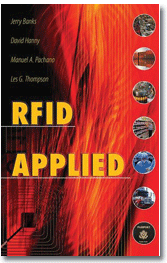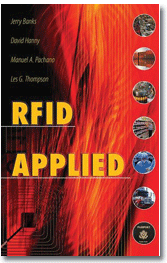Ask the Experts: Mike Marsh, Managing Directory, Trolley Scan
Mike Marsh is the Managing Director of Trolley Scan, developers of the EcoTag® UHF RFID system.
He is cited in patents embedded in numerous RFID products, mining detonators, mine communication, and free space communication.
In a recent newsletter, Trolley Scan suggested that hardware manufacturers are not preparing to meet the demands of retail RFID applications. Is this a result of simple supply-and-demand, or are there more fundamental issues slowing production?
The requirements for RFID systems in the retail environment will be the largest deployment of electronic systems in the history of mankind. The volumes needed are far beyond what we can imagine, with estimated volumes as large as 1014 (100 million million) transponders per annum. At present the world is producing an estimated 230 million per annum for applications beyond retail, a capacity that has been built up over the past 20 years. This new requirement would require a huge expansion in the current manufacturing capacity.
Transponder requirements have three major sections, namely the chip, the antenna, and the assembly of the chip and the antenna onto the goods being labeled. The chip comes from silicon foundries who have been running their plants for the past fifty years, understand mass manufacture, and are the area that is most likely to understand the volume increase problem. They will need to increase their capacity by purchasing more manufacturing equipment, building bigger premises and hiring more staff – a cycle that takes up to five years. At times this sector has been in massive oversupply, with capacity at 36% for a short time after the dot com bust, and currently at 94% after downscaling. They will not be in a hurry to run the risk of expanding too rapidly, but they are the major indicator of whether the manufacturing industry accepts there is a sustainable business in RFID production. Although companies like Intel are associated with RFID initiatives, the production at their plants could not be used for transponder production as this requires plants with different processes not used in microprocessor development.
The second challenge is the production in volumes of antennas. This will either be by extending the capacity of the printed circuit industry to etch/stamp/punch metal foils in high enough volume, or on the route of printed conductive inks where drying time is a major limitation on throughput.
To pick up a chip, attach it to the antenna and finish off the assembly requires mechanical movement of components in the assembly machinery. The inertia of those moving parts creates a practical limit of assembly rates of 7 per second (or 100 million per annum per machine). Higher throughputs are available by paralleling assembly modules and most probably the fastest available can do 400 million per annum. The throughput of these machines is also limited by the curing time of the glues and sealants used is the assembly. Although there is a lot of enthusiasm among some small players in this phase of the RFID experience, their ability to produce in the required volumes is virtually non-existent.
Could you explain the difference between TTF (tag talks first) protocols and RTF (reader talks first) protocols? How does this relate to 2nd generation EPC tags? Why is bandwidth important?
When you are the only user of a cell phone in a city, you don’t care whether your signal would interfere with other cell phone users as there are none to complain. However when you design a communication system, which will only be effective if many people make use of the system, interference issues are a key design criteria. Retail stores would need many scanners to operate in close proximity. The RF protocol between the reader and the transponders allows many transponders to be identified on a single operating frequency.
This involves the reader providing an energy field to power up the transponders in its reading zone that is also used as the control frequency for the communications that will happen between the reader and the transponders to manage the channel and allow many transponders to communicate in an ordered method through that channel. There are two classes of protocol to manage this ordered communication, namely reader-talks- first (RTF) or tag-talks-first (TTF).
In RTF protocols, the reader calls out into space a regular message, asking if a particular tag number is present. For example “Tag 1 are you there?”. A receiver on the transponder decodes this message and if it is Tag 1, it replies “yes” and the reader moves on to the next tag. In order not to call out every number in the sequence, a binary treeing algorithm is used so that the entire sequence can be covered in a short time. The reader calls out whether or not transponders are present, many calls are transmitted for each tag detected, and that the reader message is carried on the higher power transmitter signal of the reader which is received by other readers within a one kilometer radius on that frequency. Due to the high amount of calling needed for each successful reception, the calling rate has to be high which uses up wider bandwidths, usually about 200Khz per operating frequency.
In TTF protocol, the transponder sends its identity to the reader as soon as it gets sufficient operating power from the energizing field. This message is transmitted at power levels that are smaller than that of the reader signals in RTF protocols, meaning that their zone of interference is also small. The transponder in the simplest form of TTF, can send out this message at random intervals as long as it is in the energizing zone, or in more sophisticated TTF protocols, it can be instructed by the reader to cease transmission by the reader with a simple code as soon as its message is correctly received. If the message is corrupted due to many transponders talking at the same time, they will repeat their message until they are heard with no corruption. The advantage of TTF is that the message information is carried in the protocol by the transponder using a very low power transmitter which has to be less than the operating power available to the transponder, which can mean its transmitter power is as low as just 1microwatt. This message cannot be heard by the other transponders in the field due to its very low power, and will not be heard by other readers a few meters away. The bandwidth needed for communication can also be as small as 10kHz (20 times less than that of RTF) as the transponders on entering the field initiate the communication with the reader waiting in listening mode. In reality, TTF readers can be operated as close as 4 meters from each other.
As can be seen, both from the narrow bandwidth and from the signal strength used to convey the message, TTF reader systems can have operating densities in a limited RF bandwidth situation that are up to 1000 times higher than that achievable with RTF type protocols.
With the limited reader density of today’s retail environment, the importance of RTF vs. TTF is not readily apparent to users. As the number of readers increases this will inevitably force EPC to switch from the current RTF strategy.
Is the 2nd generation EPC standard doomed to failure due to inherent RF limitations? Should organizations look to technologies outside of EPC standards to meet auto-id needs?
From our own work, we know that a reliable read/write technology is a huge problem for which there is no viable solution at present. EPCglobal has developed a specification without having working systems on large scale as benchmarks.
Organizations like EPCglobal have a role to play in facilitating the development of RFID in retail. I do not think that there is another organization that would necessarily do a better job, except that it has to be understood that this is a global project, a technical project rather than a market pull project. They have to persuade serious players who can address the manufacturing shortfall to become involved for the project to succeed. It is unfortunate that the largest retail groups in the world were the ones that were providing the market pull for the fledgling RFID technology. Had the technology had a chance to succeed with an application that was within the capacities of current suppliers and grown from there, it could have more readily met the needs of retailers like Wal-Mart.
Your company indicated that many of the reported benefits of RFID are a mechanism of the underlying IT systems, achievable with traditional retail ID technology, namely barcodes. What are these general benefits? What is RFID uniquely suited to provide?
Many of the promised benefits from the future RFID systems are realizable immediately. In a retail store where the goods are checked out via scanning systems, the accounting software could already know the stock levels if told what has been delivered, as it has a record of what has been removed. There might be a shortfall via shrinkage but this is a minor adjustment.
Even track and trace can be realized by improving communication between the different participants in the chain, be it the manufacturer, the transport company and the retailer. It is not necessary to uniquely identify every box of Rice Krispies on the pallet, just actually to track the pallet of goods that is referenced by the invoice that will be issued for the goods. Once again this is a function of software and communication, and not of whether the goods are labeled by means of barcodes or RFID transponders.
RFID transponders have benefits over that of bar coding in the immediate vicinity of the reader, such as higher scanning rates, accuracy and the ability to read the identity of the goods while they are not in line of sight of the scanner. There are other benefits further down the line such as incorporating EAS features for automated checkout, but the industry is not at that point yet.
The barcode and numeric system require that all units of the same product have the same identifier in order to simplify the printing and packaging process. RFID needs to become compatible with this system so that one can just plug in an RFID scanner or a barcode scanner and run the same software. We also do not want to get to the point where the identify is such a long number that it has to be written down on an A4 sheet of paper, it must be appropriate for checking and use by manual systems as well as the electronic systems such as barcodes and RFID.



